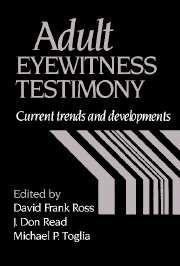Book contents
- Frontmatter
- Contents
- List of contributors
- Preface
- Part I Cognitive, physical and social processes and factors influencing eyewitness recall and identification
- Part II Lineup construction and collection of testimony
- Part III Whom to believe? Distinguishing accurate from inaccurate eyewitnesses
- 13 Distinguishing accurate from inaccurate eyewitness identifications: A reality monitoring approach
- 14 Decision times and eyewitness identification accuracy in simultaneous and sequential lineups
- 15 Individual differences in personality and eyewitness identification
- 16 Eyewitness identification confidence
- 17 Expectations of eyewitness performance: Jurors' verdicts do not follow from their beliefs
- 18 The appraisal of eyewitness testimony
- Name index
- Subject index
17 - Expectations of eyewitness performance: Jurors' verdicts do not follow from their beliefs
Published online by Cambridge University Press: 04 August 2010
- Frontmatter
- Contents
- List of contributors
- Preface
- Part I Cognitive, physical and social processes and factors influencing eyewitness recall and identification
- Part II Lineup construction and collection of testimony
- Part III Whom to believe? Distinguishing accurate from inaccurate eyewitnesses
- 13 Distinguishing accurate from inaccurate eyewitness identifications: A reality monitoring approach
- 14 Decision times and eyewitness identification accuracy in simultaneous and sequential lineups
- 15 Individual differences in personality and eyewitness identification
- 16 Eyewitness identification confidence
- 17 Expectations of eyewitness performance: Jurors' verdicts do not follow from their beliefs
- 18 The appraisal of eyewitness testimony
- Name index
- Subject index
Summary
Eyewitness identification has been cited as perhaps the single most persuasive source of evidence (for example, Loftus, 1979; Woocher, 1977), but also as the most frequent cause of wrongful convictions (Rattner, 1988). Generally speaking, eyewitnesses are considered by jurors to be a credible source of evidence. Wells, Lindsay, and colleagues found that eyewitness confidence was a major determinant of witness credibility, accounting for as much as 50 percent of the variability in mock juror belief of eyewitness testimony (Lindsay, Wells, & Rumpel, 1981; Wells, Ferguson, & Lindsay, 1981; Wells, Lindsay, & Ferguson, 1979). An extensive literature exists indicating that there is a small positive association between confidence and accuracy probably, but not one of sufficient size to make confidence a reliable criterion of identification accuracy (for example, Wells & Murray, 1984). Even if the confidenceaccuracy relationship is reliable immediately following identification, there are many reasons to believe that this relationship will not exist in the courtroom (for example, Wells, Lindsay, & Tousignant, 1980). Leippe (1980) provides a particularly thorough and insightful discussion of these issues.
Other factors that might influence juror belief of eyewitness testimony include the internal consistency of the evidence given, agreement or disagreement among multiple witnesses, and physical features of the situation that might reasonably be expected to influence eyewitness accuracy (such as lighting, length of exposure, and so forth; Wells & Lindsay, 1983). Work in my laboratory has continued to support the importance of eyewitness confidence (for example, Lindsay, Wells, & O'Connor, 1989), but has produced inconsistent evidence in support of other factors as determinants of mock juror belief of eyewitness testimony (reviewed below).
- Type
- Chapter
- Information
- Adult Eyewitness TestimonyCurrent Trends and Developments, pp. 362 - 384Publisher: Cambridge University PressPrint publication year: 1994
- 33
- Cited by

